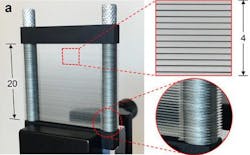Polarizing beamsplitter and isolator for terahertz radiation are made of 'artificial dielectric'
Researchers at Brown University (Providence, RI) and Osaka University (Osaka, Japan) have developed a new method of manipulating the polarization of light at terahertz frequencies, resulting in the creation of polarizing beamsplitters and isolators that have far better performance than pre-existing devices.1
While the new polarizer may look a lot like a wire-grid polarizer, which is commonly used at terahertz and higher frequencies, it is different. Instead, the technique uses stacks of spaced metal plates. Each pair of plates forms a parallel-plate waveguide. When terahertz light impinges on the stack at a 45° angle, it splits the beam by exciting two waveguide modes. Vertically polarized light passes through the device, while horizontally polarized light is reflected in a 90° angle.
The technique has a number of advantages over traditional wire filters, the researchers say. The stack-of-plates architecture, which is known as an "artificial dielectric," is easy to make, and the materials are inexpensive. The plates are also much less fragile than wires.
With the addition of a second similar artificial-dielectric structure, the researchers built an isolator. A terahertz isolator could be an important component for future high-powered terahertz devices.
Performance of the devices was exceptional: the beamsplitter has an extinction ratio as high as 42 dB and an insertion loss insertion loss as low as 0.18 dB, while the isolator has an isolation of 52 dB and an insertion loss of less than 1 dB at a frequency of 0.46 THz.
The Brown and Osaka researchers are in the process of patenting the new artificial-dielectric devices.
Source: http://news.brown.edu/articles/2017/07/terahertz
REFERENCE:
1. Rajind Mendis et al., Nature Scientific Reports (2017); doi: 10.1038/s41598-017-06297-7

John Wallace | Senior Technical Editor (1998-2022)
John Wallace was with Laser Focus World for nearly 25 years, retiring in late June 2022. He obtained a bachelor's degree in mechanical engineering and physics at Rutgers University and a master's in optical engineering at the University of Rochester. Before becoming an editor, John worked as an engineer at RCA, Exxon, Eastman Kodak, and GCA Corporation.
